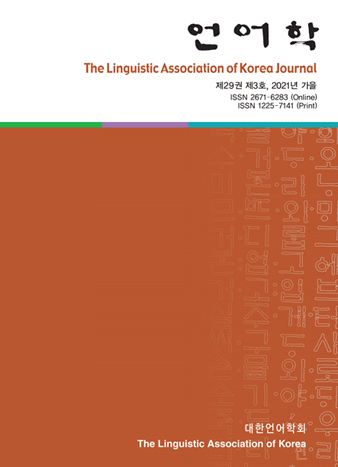대한언어학회 전자저널
29권 3호 (2021년 9월)
- On the Edges of Korean NP
-
YongSuk Yoo
Pages : 129-141
Abstract
Yoo, YongSuk. (2021). On the edges of Korean NP. The Linguistic Association of Korea Journal, 29(3), 129-141. This paper shows that a particular pattern in Korean Possessor Raising constructions can be accounted for if only the highest specifier of NP counts as a phasal edge. This paper contributes to the ongoing debate of the contextuality of phasal edgehood: The status of a Spec/adjunct regarding the phasal edge can be affected by the syntactic context in which the Spec/adjunct appears. In particular, only the highest specifier of NP counts as a phasal edge and the lower specifier of NP is only accessible when the highest one undergoes movement. This article also discusses issues regarding the syntax and semantics of adjectives and possessors in Korean nominal phrases, arguing that adjectives and possessors in Korean are NP-adjuncts and there is no functional projection such as DP. This also sheds a new light on the discussion of Korean possessor raising constructions.
Keywords
# phase # edge # NP # Korean # possessor raising
References
- Bošković, Ž. (2005). On the locality of left branch extraction and the structure of NP. Studia Linguistica, 59, 1–45.
- Bošković, Ž. (2008). What will you have, DP or NP? In Proceedings of the 37th Annual Meeting of the North East Linguistic Society.
- Boškovic, Ž. (2012). On NPs and clauses. In G. Grewendorf & T. E. Zimmermann (Eds.), Discourse and grammar (pp. 179–246). Berlin: De Gruyter Mouton.
- Bošković, Ž. (2016). Getting really edgy: On the edge of the edge. Linguistic Inquiry, 47, 1-33.
- Bošković, Ž., & Hsieh, I.-T.C. (2012). On word order, binding relations, and plurality within Chinese NPs. In Proceedings of the 13th International Symposium on Chinese Languages and Linguistics, 19-47. Taipei: National Taiwan Normal University.
- Choe, H.-S. (1986). Syntactic adjunction, A-chain and the ECP-multiple identical case construction in Korean. In Proceedings of the 17th Annual Meeting of the North East Linguistic Society.
- Chun, S.-A. (1985). Possessor ascension for multiple case sentences. Harvard Studies in Korean Linguistics, 1, 30-39.
- Despic, M. (2011). Syntax in the absence of determiner phrase. Unpublished doctoral dissertation, University of Connecticut, Storrs, CT.
- Despić, M. (2013). Binding and the structure of NP in Serbo-Croatian. Linguistic Inquiry, 44, 239-270.
- Kang, J. (2014). On the absence of TP and its consequences: Evidence from Korean. Unpublished doctoral dissertation, University of Connecticut, Storrs, CT.
- Ko, H. (2005). Syntax of why-in-situ: Merge into [Spec, CP] in the overt syntax. Natural Language & Linguistic Theory, 23, 867–916.
- Kuo, P.-J. (2009). Possessor raising and BA construction. In: Proceedings of the 21st North American Conference on Chinese Linguistics, 291-303.
- Tomioka, S., & Sim, C.-Y. (2005). Event structure of the inalienable possession in Korean. University of Pennsylvania Working Papers in Linguistics, Vol. 11, Article 22.
- Ura, H. (1995). Multiple feature-checking: A theory of grammatical function splitting. Unpublished doctoral dissertation, MIT, Cambridge, MA.
- Yoo, Y.-S. (2019). Mobility in syntax: On contextuality in labeling and phase. Unpublished doctoral dissertation, University of Connecticut, Storrs, CT.
- Yoo, Y.-S. (2021). ECM and scrambling at the edges of CP in Korean. Studies in Generative Grammar, 31, 211-226.
- Yoon, J.-M. (1997). The argument structure of relational nouns and inalienable possessor constructions in Korean. Language Research, 33, 231-264.
